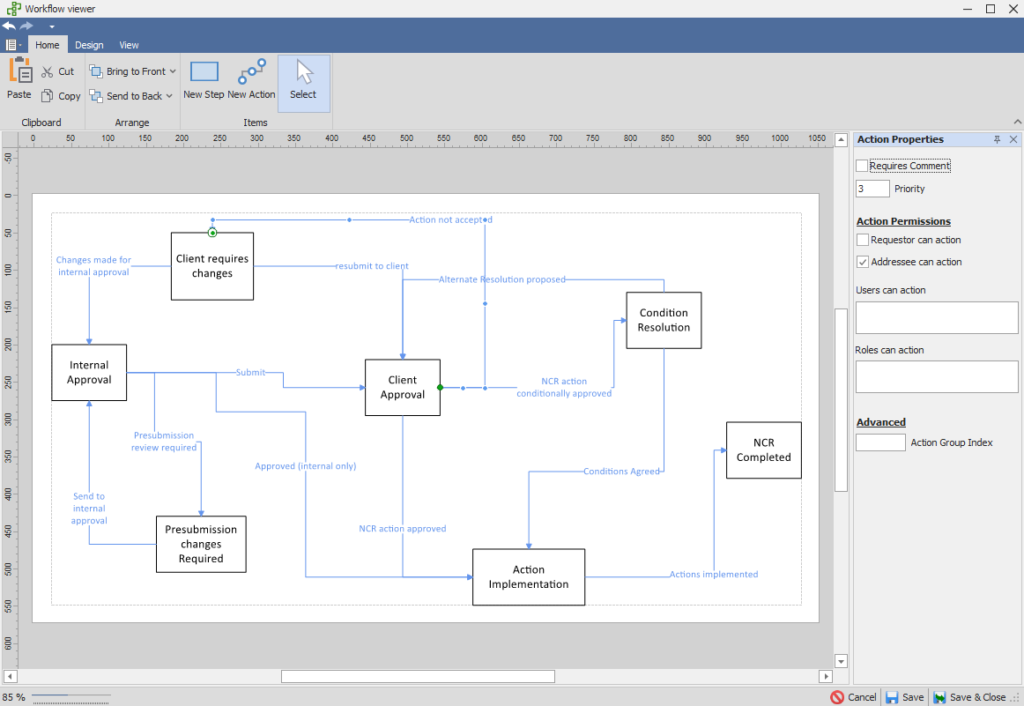The new approval system
- Fully customisable workflows
- Unlimited steps means completely customizable statuses for each different approval category (NCR, Hold Point, Witness Point, Check and PO)
- Independent Approvals
- Default workflows for specific hold/witness points
- Standing Approvals
- Updated templating system
The big news – fully customisable workflows
In civil pro 11 we have introduced approval workflows. Each workflow is a diagram of unlimited complexity when an approval starts at a given step, and is actioned by an approved person to reach the next step. It continues until an end step is reached. At any given point, an approval’s status is the latest step reached. The workflow is managed visually through 100% customisable diagrams.
Each different category of approval (HP, WP, Check, NCR or PO) has at least one workflow template that can be assigned to a new approval. When a template is selected for e.g. a Hold Point, the workflow is copied to the specific Hold Point. Once the workflow is started, any relevant users are notified and the current step is available for action.
Status (steps)
The status of an approval is simply the last actioned step. In Fig 1, when the workflow is started, it has the status Internal Approval. If a user completes the Submit action is completed:
- The action is logged against workflow along with any comments from the actioner
- The status becomes Client Approval
- Users that can action the new status are notified (along with any addressees or CCs)
Steps can be marked private. When the current step is marked private, the approval is not shown on the mobile platform, and notifications are not sent to addressees – they are only sent to users that can specifically action the step. This allows the implementation of internal approvals – e.g. prior to pulication of an NCR.
Actions
A workflow progresses through actions applied to a step. An action can only be completed by a user with the appropriate permissions. Permissions for an action are generally assigned as;
- Addressee can action
- Requester can action
Other permissions can be assigned – such as in the case of actions for private steps. In this case you may want to assign permissions on the basis of user or role. You can see in right hand side panel in Fig 1 that the selected action can be complete only by the Requestor.
Independent Approvals
With v11 we have introduced independent approvals. These are an approval that is not linked to an NCR, PO or Checklist Item. Uses for an independent approval may be Management Plans, authority approvals or global project approvals that you want to later link to other records. This is especially powerful when combined with Standing Approvals.
Standing Approvals
A standing approval is an approval that is linked to a checklist template line. For example, you may have a concrete checklist template with a line Mix Design Complies, and a completed approval for the Mix Design. You can now link the approval to the Mix Design Complies line in the checklist template. Every time a new checklist is created from this template, the corresponding checklist line will also reference the Approval. Cool huh?
Updated Templating System
Not that there was anything wrong with the old one. Its just that we use the same database across our Desktop, Mobile and upcoming cloud versions. Our previous templating system relied on a Rich Text Editor – similar to Microsoft Word. The problem with this is that you can’t easily implement this on the web. In response we have implemented a standard templating language called Handlebars (https://handlebars-draft.knappi.org/). This allows us to create more sophisticated templates for emails and approvals.
